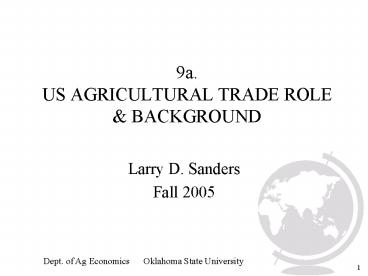9a' US AGRICULTURAL TRADE ROLE PowerPoint PPT Presentation
1 / 17
Title: 9a' US AGRICULTURAL TRADE ROLE
1
9a.US AGRICULTURAL TRADE ROLE BACKGROUND
- Larry D. Sanders
- Fall 2005
Dept. of Ag Economics Oklahoma State
University
2
BASIC PROPOSITIONS OF TRADE
- 1. SCARCITY--Trade based on relative scarcity of
factors of production - 2. PRICES--Relative scarcities lead to different
relative prices within countries if no trade
(autarky) - 3. PROFIT--Different relative prices lead to
opportunities for profit with trade - 4. SPECIALIZATION--Flow of trade leads to longrun
adjustment within domestic economies, leading to
increases in export specialization
3
BASIC PROPOSITIONS (cont.)
- 5. PROFIT--Specialization leads to increased
profit - 6. INCOME--Fundamental Proposition
- Increasing trade leads to increased income
- 7. ECONOMIC GROWTH--Increased income provides
additional capital for domestic investment - 8. STANDARD OF LIVING--Increased domestic
investment leads to more economic growth, thus,
higher standard of living
4
AG EXPORT BOOM OF THE 1970s US AGRICULTURAL
TRADE BALANCE (mil/FY ag product only)
- EXPORTS INCREASE
5
AG EXPORT BOOM OF THE 1970s SOURCES
- HIGH OIL PRICES FOREIGN ECONOMIC GROWTH
- EASY CREDIT
- SOVIET UNION IMPORTS
- CROP SHORTAGES
- U.S. DOMINANCE
- WEAK U.S.
6
AG EXPORT BOOM OF THE 1970s CONSEQUENCES
- INCREASED FARM INCOME
- HIGHER COMMODITY FARM LAND PRICES
- NEW INVESTMENT INCREASED PRODUCTIVITY
- AGRICULTURAL TRADE SURPLUS
7
AG EXPORT BUST OF THE 1980s US AGRICULTURAL
TRADE BALANCE (mil/FY ag product only)
- EXPORTS GENERALLY DECLINE
8
AG EXPORT BUST OF THE 1980s CAUSES
- STRONG
- WEAK WORLD ECONOMY
- WORLD DEBT PROBLEMS
- EXPORT COMPETITION
- TRADE BARRIERS
9
AG EXPORT BUST OF THE 1980s CONSEQUENCES
- GLOBAL RECESSION LOWER OIL PRICES
- DECLINING MARKET GROWTH
- PROTECTIONISM
- STRONG U.S. ROLE OF FARM PROGRAMS
- EMERGENCE OF EC AS MAJOR EXPORTER
- REDUCED FARM INCOME
10
AG EXPORT BUST OF THE 1980s CONSEQUENCES (cont.)
- U.S. GRAIN SURPLUS
- LOWER COMMODITY PRICES
- REDUCED FARM LAND VALUES
- FARM FINANCIAL STRESS
11
AG EXPORT BOOM OF THE 1990sUS AGRICULTURAL TRADE
BALANCE (mil/FY ag product only)
12
AG EXPORT RECOVERY OF THE 1990s
- MULTILATERAL AGREEMENTS
- DOMESTIC INTERVENTION
- ECONOMIC GROWTH
- SELF-SUFFICIENCY UNCERTAINTY
- MATURING DEVELOPED MARKETS
- DEVELOPING NEWLY EMERGING MARKETS
- POTENTIAL FOR INSTABILITY
13
Value-Added Exports
- More Employment/Income than bulk commodities
- Job/Economic Activity Retention
- Economic Growth Contribution Greater than Non-Ag
Sectors - 1960-1990 9X increase
- US share less than 10
- Half of US ag exports are value-added
- Trend increasing
14
AG EXPORT BOOM-BUST CYCLE? US AGRICULTURAL TRADE
BALANCE (mil/FY ag product only 5-yr data)
- EXPORTS INCREASE--cyclically
15
SUMMARY
- Export boom-bust cycle
- Exists over past 30 years
- Export trend remains up
- More market-oriented
- Competitiveness important
- Protective response
- Trade future uncertain
- Trade agreements seem to moderate cycle
- Trade talks uncertain
- Lessons for agricultural producers, agribusiness
rural communities
16
READING/SOURCES
- Ahearn, R.J. An Overview of the International
Trading Environment, Managing Trade Relations in
the 1980s. Rubin Graham, eds. Allanheld Pub.,
1983. - Drabenstott, M. et al. The Latin American Debt
Problem U.S. Agriculture, Economic Review,
Federal Reserve Bank of Kansas City, July/Aug
1988.
17
READING/SOURCES (cont.)
- Henneberry, D. et al. A Weaker Dollar U.S.
Farm Exports Coming Rebound or Empty Promise?,
Economic Review, Federal Reserve Bank of Kansas
City, May 1987. - Jackson, J.H. The World Trading System.
Cambridge MIT Press, 1989. - Rosson, P. International Marketing for
Agribusiness Concepts Applications. GEMS, TAMU
Press, 1994. - Southern Extension International Trade Task
Force. Southern Agriculture in a World Economy.
Department of Agricultural Economics, Oklahoma
State University. - USDA, FATUS Series (annual data).

